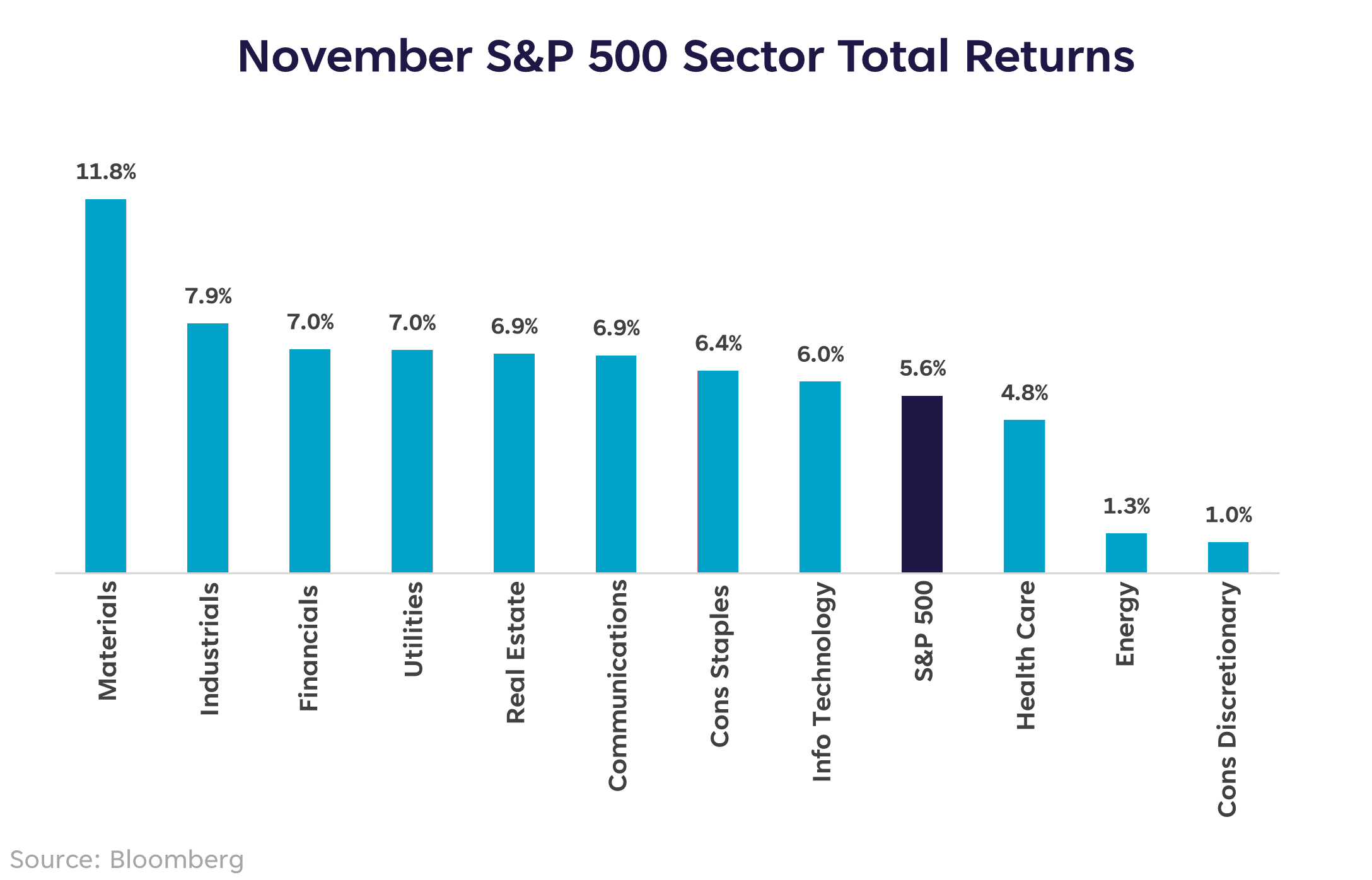November 2022 Market Lookback
By: Liz Young Thomas · December 02, 2022 · Reading Time: 4 minutes
After declining to start the month, promising inflation data unleashed a wave of risk-on sentiment despite an uptick in unemployment. Home sales & housing prices continued to decline, as the residential sector bore the brunt of the slowdown in economic activity. Analyst estimates for corporate earnings were revised downward on the intensifying economic headwinds, as longer-term Treasury yields fell substantially while shorter-term yields continued to rise.
Macro
• The Federal Reserve raised the fed funds rate by 75bps to an upper bound of 4.0% & indicated rates may need to be raised further than previously anticipated.
• Oct CPI came in below expectations on both a headline & core basis, at 7.7% & 6.3% y/y and 0.4% & 0.3% m/m, respectively.
• According to the S&P/Case-Shiller 20-city composite, home prices declined 1.2% in September.
• Oil fell 6.9%, undoing most of its Oct rebound and remaining in its post-May downtrend.
Equities
• Stocks sold off in the aftermath of a hawkish post-FOMC meeting presser, before rallying 8.9% on the back of a lower-than-expected CPI print.
• S&P 500 EPS estimates for 2023 declined from $234 to $230 in November, only 2% above the 2022 EPS estimate of $225.
• Both developed & emerging international markets outperformed US stocks, buoyed by the US dollar depreciating 5% against other major currencies.
• The gap in performance between Large-cap Value (+6.2%) & Small-cap Growth (+1.6%) stocks was 4.6% in November, the largest since April.
Fixed Income
• The Treasury yield curve bull flattened significantly in November (long-term yields decreased faster than short-term)—the 1-Yr yield rose 8bps while the 10-Yr yield fell by 45bps.
• Investment grade (IG) corporate bonds had their best month of total returns since April 2020, buoyed by the decline in long-term yields.
• High Yield (HY) bond funds saw $5.1bil in net inflows, continuing the large inflows of the prior month.
Crypto
• The collapse of cryptocurrency exchange FTX led to a fresh wave of selloffs, with fears of a domino effect spreading across the crypto lending space.
Energy Divergence
Despite rallying in October, crude oil prices returned to their recent downtrend and fell 6.9% in November. According to analysis by the NY Fed, most of the observable drivers of the Nov price decline came from increases in supply expectations, while the decline in prices over prior months largely came from lower global demand.
Energy stocks initially tracked the fall in oil prices, declining over 26% from Jun 8 to Jul 14, but since then have rebounded strongly while oil prices continued falling. In Q4 thus far, oil prices are up 1.3% yet stocks are up 25.7%. This sort of price action is atypical—lower oil prices should weigh on energy companies’ ability to generate profit, all else equal. In fact, rolling 40-day correlation between oil prices & the energy sector fell from 0.80 at the end of Q3 to 0.43 at the end of November.
It’s unclear if this divergence in energy commodities & stocks will persist. It wouldn’t be surprising to see them eventually converge, but it’s anyone’s guess if that means oil prices bounce back or if the energy sector cracks under the pressure of lower prices.
Implications of Midterm Elections
Republicans secured control of the House in November midterm elections, while Democrats lost nine seats. Control of the Senate remained in Democratic hands, and the outcome of Georgia runoff elections could secure a true majority for Dems with 51 seats. All this to say, Congress is split and midterms ushered in a divided government starting in 2023. This reduces the likelihood of major policy changes being enacted in 2023/2024, and it is widely believed that capital markets tend to react positively to government “gridlock.”
Bipartisan talks on a new budget and raising the debt ceiling will likely be the main points of activity before the new year. Failing to settle these matters passes fiscal risk into 2023, which would likely occur alongside weakening earnings growth & near-certain recession in Europe.
Such a set-up would share similarities with 2011—significant debt ceiling brinkmanship in the summer of 2011 occurred against the backdrop of an earnings slowdown & the eurozone debt crisis. That year, the S&P 500 rallied 7% through July 22nd before falling 17% over the next two weeks as the debt ceiling standoff intensified. Volatility rose to its highest level since the 2008-09 financial crisis & remained elevated through the end of Q3.
Performance data quoted represents past performance. Past performance does not guarantee future results. Market returns will fluctuate, and current performance may be lower or higher than the standardized performance data quoted.



